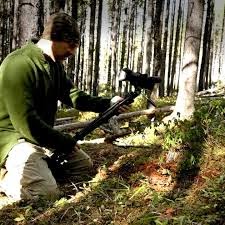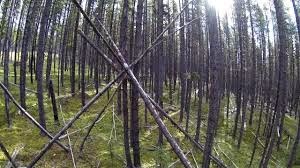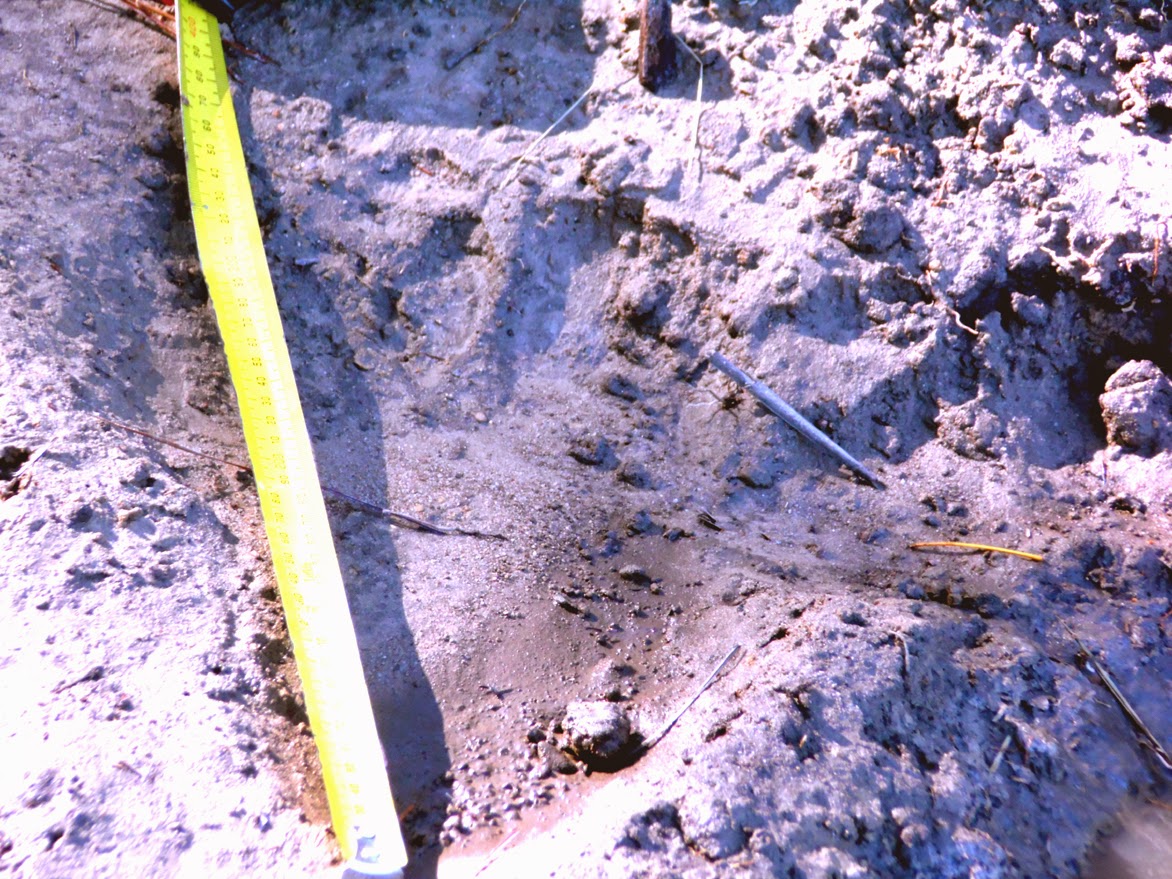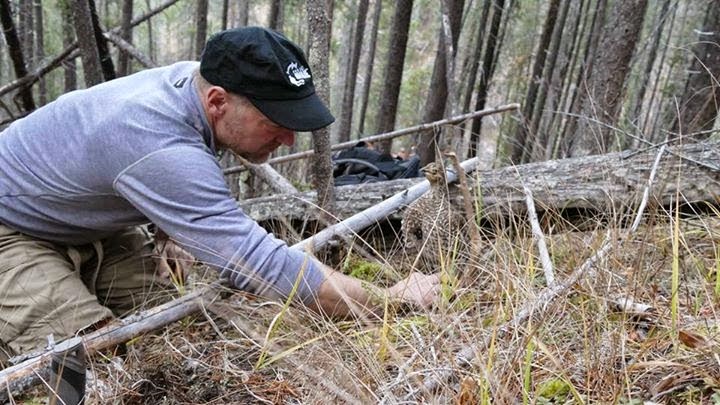Survivor Man: Bigfoot
In the words of Survivor Man Les Stroud he is not a big-footer, nor an enthusiast nor is he a witness to a sighting. He is a man who has had some experiences and he now wants answers – The truth. These are in his words in the new episodes of ‘Survivor Man Bigfoot’ airing in the US this April in which Les heads to deepest and most remote parts of Canada and the United States in his ‘quest’, for Bigfoot or at the very least proof or signs of a large Apex predator is living in North America. For a self described non believer we can follow Les through this series as he applies balanced scientific view in his work and is challenged by a series of events that has him questioning his beliefs about this creature. His guide, Todd Standing, is barely seen in these new adventures
In my view, this series is by far an away the most professionally produced series of documentaries on the subject that I have ever seen. Even the older ‘Monster Quest’ and ‘In Search of ‘ series was very informative but this is by far the superior in terms of content that is relevant to not only the man in the street but also in some measure the field researcher where as so many contemporary shows fail. A man (or men) on the ground, searching, looking for signs, setting up feeding stations – applying their field craft in a methodical, thoughtful and professional way. This is how the subject matter needs to be handled and produced if we are serious on the content, and Stroud seems serious to me.
Now many of you will say, ‘sure but he makes money from it or he gets paid for doing it’ well of course he does, a documentarian is who he is, it’s what he does. I have always maintained that it doesn’t bother me in the slightest if people get paid for this work, so long as the content is genuine, first rate, follows scientific principles and is well produced. This certainly meets my criteria. In the plethora of poorly produced US cable shows on this subject, IE: Mountain Monsters, which make more of a mockery of the subject than rather provide a critical view, only serve to tarnish or to belittle the work of us genuine researchers in the view of the public at large.
 |
| Todd Standing and Les Stroud on location in Alberta, Canada |
Stroud goes about his work methodically in this series and there are several points I wish to address and how this work clearly demonstrates the validity of the work in Australia in our search for the Yowie. The one impressive quality that Stroud brings to the field is his impressive knowledge in photography and more over small covert devices. Having a strong understanding of camouflage and allowing things such as DNA traps and concealed hard disk records to be practically invisible in his quest is an area that we all are striving to achieve. Herein lays the benefit of being a professionally produced program via his network given that there are far more expert camera technicians that us ordinary fold can access.
In our work as researchers regardless of where are in the world and regardless of our quarry we must, through our own initiative and expense embrace and become, at some level, a Primatologist, Anthropologist, Biologist, Geneticist, Photographer, Outdoorsman, Trackers, Botanist – all of these things we must invest hours in knowing and using discipline in acquiring if we are to be and taken as serious for the reality is that we are in fact on our own and have only each other to work off. If we where perhaps millionaires who can engage a large range of paid specialists and an array of DNA labs then it would be vastly different. Stroud shows some simple techniques that if your not already using then you will find useful. He makes many good points, especially about remaining objective when in the field
As mentioned, there are several points I need to raise that I observed in this program that will in many ways answer a lot of our own questions as it relates to purported evidence in this country. I will say that I am somewhat disappointed that they (Standing & Stroud) kept this search strictly terrestrial, it tells me that perhaps Stroud should broadened his horizons a little further as we know in this country via our work and work and testimony of others that are also Arboreal. This was evidenced when several US based video-bloggers identified object(s) in tree’s, photobombing the episode. I must say that some of these items are compelling.
 |
| Les sets one of his hidden Camera’s and DNA Traps at a feeding station |
Tree breaks – After watching the series so far I am even more convinced the role tree breaks can play for our work here, I am uncertain if we actually ever understood the true significance of them. We are a long way away from knowing what they mean but we have them as they are found in the US. In a line or in a direction serving as boundary markers perhaps. The one truly critical point to consider for us here is that in 99% of our country we do not have snow fall. So no breaks here can be caused in that way, rotting, yes perhaps, but not in sequence and certainly not in freak regularity.
| A nearly identical stick structure found by us in 2012 |
Les makes a great point, something else that we all can forget at times. When we are in area and we get to know the area. We need, no we must develop a baseline for what is normal in the region, what is the norm in terms of terrain or dead falls etc for when we know that we have a much greater awareness of what is not normal in the bush, what could not be naturally made or constructed by chance
 |
|
A tree Structure that Stroud finds in
Alberta.
|
The final point I would ask you to consider in comparing results in the US, in particularly pointed out in this program that really, at least for me, sends home a strong point and thats on foot prints. My US colleagues tell me that for the untrained novice researcher it is very easy to confuse a bear track with a Sasquatch print. Especially if the bear is walking in another bears tracks. You then get an elongated track that is easily confused with Bigfoot.
 |
| A Bear print for Canada |
How does this help us? well we don’t have bear’s, there are virtually no people I have ever seen with a 42 inch length print found in the middle of the Australian bush, regardless if it is semi used location. I believe we take this fact for granted and that we really do not consider the gravity of this reality. The skeptics will says its anything other than the single prints of a large bi pedal creature.
 |
| A 44 Inch foot print found by The Australian Yowie Project in June 2013 |
By looking at these two photos we can see that for us here in our work there is no confusion. There is no doubt. It is a salient point worth noting despite if you think that I have pointed out the bleeding obvious.
Our job should be easier, we dont have wolves, cougars, brown bears, black bears, wolverines, and a host of other predatory animals that not only confuse and potentially erase Sasquatch evidence for the equation is simple. Its either human as we know it or its not.
In conclusion we need more people in the bush with better quality equipment. Make your own Survivorman style programs for the more people out looking and applying basic scientific principles the sooner we can move onto the next phase of our work which is to study them. Finding them is only a quarter of the job.
Les Stroud has produced a brilliant series that has great content for all. It is a professional and serious look and a subject that has been dealt with by ridicule in the main stream media for decades. Finally a critical point of view and he gets results
– Cheers
Ray Doherty
NB: All images where found and supplied by google and as such are and remain in the public domain and a matter or public record) All other Images are and remain the copyright of the Australian Yowie Project (C) 2015




We do have both black leopards and puma’s in south gippsland. They are most definitely NOT big feral cats. Have closely experienced and observed both leopards and tigers in Nepal, both adult and from 6-12 mths old. Had extremely close encounter with black adult leopard in south gippsland, 4 kms from my home and know one of the 2 people who organised the release of 6 puma’s locally as they were starving due to business going broke. These were released here as it was known black panthers were already here from past releases by same sources going back generations. In captivity puma’s have only been known to interbreed with leopards. In these documented cases the offspring were shorter than either parent. I was raised on a farm locally and an avid spotlighter. The leopard was in what l call zoo condition compared to those in the wild in natural environment, probably due to more regular successful hunts and no real competition for food sources. Have had other sightings over the years but not close. Found big cat prints in another area 40 kms away from my home which was much larger than a cast of 1 yr old male tiger l bought back from Nepal. I have also seen a stunted black leopard in an aussie circus. It was only about 1 metre in length including it’s half tail. The rest of tail was missing and had red skin on the stump. A large feral cat could easily be bigger than this example BUT you wouldn’t mistake it for one because the bone structure was all big cat which is completely different to a big feral cat which will still have finer bone structure no matter it’s size.